
Science with Passion
Application No.: VFD0177 Version 1 06/2019
Purification of epigallocatechin gallate and other related polyphenols from green tea by mass-triggered fractionation
Jan Wendrich, Maria Glanz, Kate Monks; applications@knauer.net
KNAUER Wissenschaftliche Geräte GmbH, Hegauer Weg 38, 14163 Berlin

Summary
Epigallocatechin gallate is one of the major metabolites in green tea material and has shown positives effects on human health in several studies. This target molecule was isolated together with three other polyphenolic compounds in a short time with an AZURA® Preparative HPLC system using mass-triggered fractionation. The number of fractions was reduced to a minimum by this technique leading to a significant decrease in past analysis time showing that mass-directed purification is the ideal method in the isolation of natural products.
Introduction
Catechins are polyphenolic metabolites that appear in plants. These molecules from the group of flavonoids gained a lot of interest over the past decades due to their antioxidant properties. Especially, epigallocatechin gallate was subjected to intensive research regarding its positive effects on human health. It can be purchased as a dietary supplement but is also available in high amounts in green tea leaves. Here, we present an easy and time-saving method for the isolation of epigallocatechin gallate and other related catechins from a green tea extract based on the technique of mass-triggered fractionation.

Structure of Epigallocatechin gallate (Catechin)
Results
A method for the isolation of epigallocatechin gallate from green tea extract was developed on analytical scale using an AZURA Analytical HPLC plus system and an Eurospher II C18 column (Fig. 1). The developed method was then transferred to the AZURA Preparative system with the ability to fractionate via molecular mass (Fig. 2). One fraction with the desired mass for epigallocatechin gallate (m/z 457.4; [M-H]-) was collected (Fig. 3). In addition to this fraction, three further fractions corresponding to epicatechin, epicatechin gallate and epigallocatechin (m/z 289.2; m/z 305.2; m/z 441.4; [M-H]-) were collected. The following HPLC analysis of the target fraction showed that it was possible to isolate epigallocatechin gallate with the technique of mass-triggered fractionation with a purity of >95 % (Fig. 4). Also, three other catechins were isolated by this method in the purity of >90 % (Fig. A1-A3).
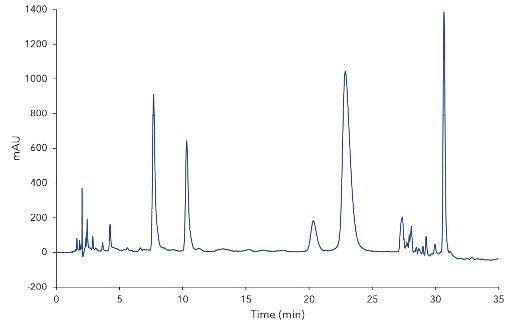
Fig. 1 Analytical chromatogram of the crude green tea extract at 220 nm; step gradient separation 10 % acetonitrile until 26 min, then 15 % acetonitrile
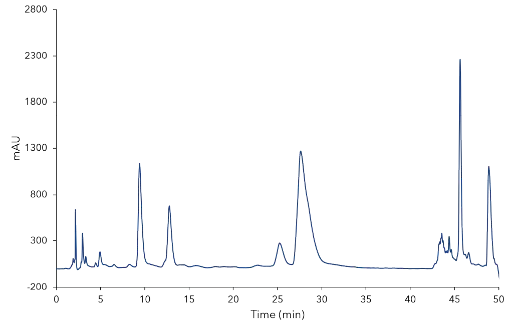
Fig. 2 UV chromatogram of a purification run for the crude green tea extract at 220 nm

Fig. 3 SIM (single ion monitoring) chromatogram of a purification run for the target mass of m/z 457.4

Fig. 4 Analytical chromatogram of the third fraction containing epigallocatechin gallate (m/z 457.4; [M-H]-); linear gradient separation 5 %-50 % acetonitrile
Material and Methods
AZURA Analytical HPLC Plus system was used for the method development. Method optimization on this analytical system led to a step gradient, which was used for the isolation of polyphenols from green tea.
AZURA Preparative HPLC system was used for the mass-directed purification of epigallocatechin gallate. The system consisted of an AZURA P 2.1L pump equipped with a 250 mL pump head and a three channel low pressure gradient (LPG) ternary module, a manual injection valve (1/8’’, 6 port 2 position) equipped with a 5 mL sample loop, an AZURA UVD 2.1S detector equipped with a 3 mm flow cell, a 4000 MiD mass spectrometer with the MiDas sampling unit, a Foxy R1 fraction collector and an Eurospher II 100-5 C18 150 x 20 mm column. The step gradient method run for 50 min at a flow rate of 18.9 ml/min with the following composition: 0 min 10 % B, 40 min 10 % B, 40.1 15 % B, 50 min 15 % B, with 0.1% formic acid in water (A) and acetonitrile (B) as eluents. The wavelength of the detector was set to 220 nm at a data rate of 10 Hz, while the mass selective detector was set to negative SIM mode monitoring the masses of m/z 289.2, 305.2, 441.4, 457.4.
The green tea extract was prepared by sonification of ground green tea leaves with 75 % ethanol for 60 min, followed by filtration and the dilution in a ration of 1:1 with water.
Conclusion
Epigallocatechin gallate is one of the major metabolites in green tea. This target molecule was isolated together with three other polyphenolic compounds in a short time with an AZURA Preparative HPLC system using the technique of mass-triggered fractionation. The number of fractions was reduced to a minimum by this technique leading to a significant decrease in past analysis time.
Additional Results
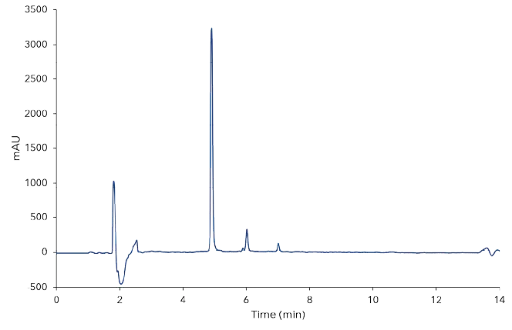
Analytical chromatogram of the first fraction containing epigallocatechin (m/z 305.2; [M-H]-); linear gradient separation 5 %-50 % acetonitrile.
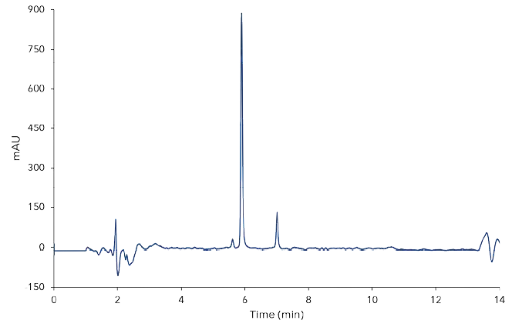
Analytical chromatogram of the second fraction containing epicatechin (m/z 289.2; [M-H]-); linear gradient separation 5 %-50 % acetonitrile.
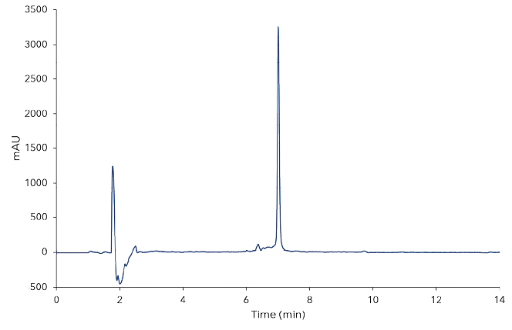
Analytical chromatogram of the fourth fraction containing epicatechin gallate (m/z 441.4; [M-H]-); linear gradient separation 5 %-50 % acetonitrile.
Additional Materials and Methods
Tab. A1 Method parameters (preparative)
Eluent A | Water + 0.1% formic | acid | |
Eluent B | Acetonitrile | ||
Gradient | Time (min) | %A | %B |
0 | 90 | 10 | |
40 | 90 | 10 | |
40.1 | 85 | 15 | |
50 | 85 | 15 | |
Flow rate | 18.9 mL/min | System pressure | 120 bar |
Column temperature | RT | Run time | 50 min |
Injection volume | 500 µL | Injection mode | - |
Detection wavelength | 220 nm | Data rate | 10 Hz |
Time constant | 0.1 sec |
Method parameters (mass spectrometer)
Scan mode | SIM (Single Ion Monitoring) |
Scan rate | 1 Hz |
Step | 0.2 |
SIM | 289.2 m/z, 305.2 m/z, 441.4 m/z, 457.4 m/z |
Ion mode | Negative |
Gas flow | 2.5 l/min |
System configuration & data (analytical system)
Instrument | Description | Article No. |
Pump | AZURA P 6.1L | |
Autosampler | AZURA AS 6.1L | |
Detector | AZURA DAD 2.1L | |
Flow cell | PressureProof flow cell 10 mm, 10 µl | |
Column | Eurospher II 100-5 C18 with precolumn, Vertex Plus Column 150 x 4.6 mm | |
Software | ClarityChrom ClarityChrom 8.1 - PDA extension |
System configuration & data (preparative system)
Instrument | Description | Article No. |
Pump | AZURA P 2.1L AZURA LPG module for Pump P 2.1L | |
Injection | AZURA V 2.1 | A1359 |
Sample loop | 5 ml sample loop | |
Detector | AZURA UVD 2.1S | |
Flow cell | Semi-preparative UV flow cell 3 mm, 2 µl | |
Mass spectrometer | 4000 MiD with MiDas | |
Fractionation | Fraction collector Foxy R1 | |
Column | Eurospher II 100-5 C18, Column 150x20 mm | |
Software | PurityChrom 5.9.69 PurityChrom Upgrade to full version PurityChrom MS license |
Related KNAUER Applications
VPH0067 - Easy and fast isolation of rosmarinic acid from lemon balm with mass-directed purification
Application details
|
Method |
LC-MS |
|
Mode |
RP |
|
Substances |
epigallocatechin gallate, catechin |
|
CAS number |
989-51-5 |
|
Version |
Application No.: VFD0177 | Version 1 06/2019 | ©KNAUER Wissenschaftliche Geräte GmbH |


